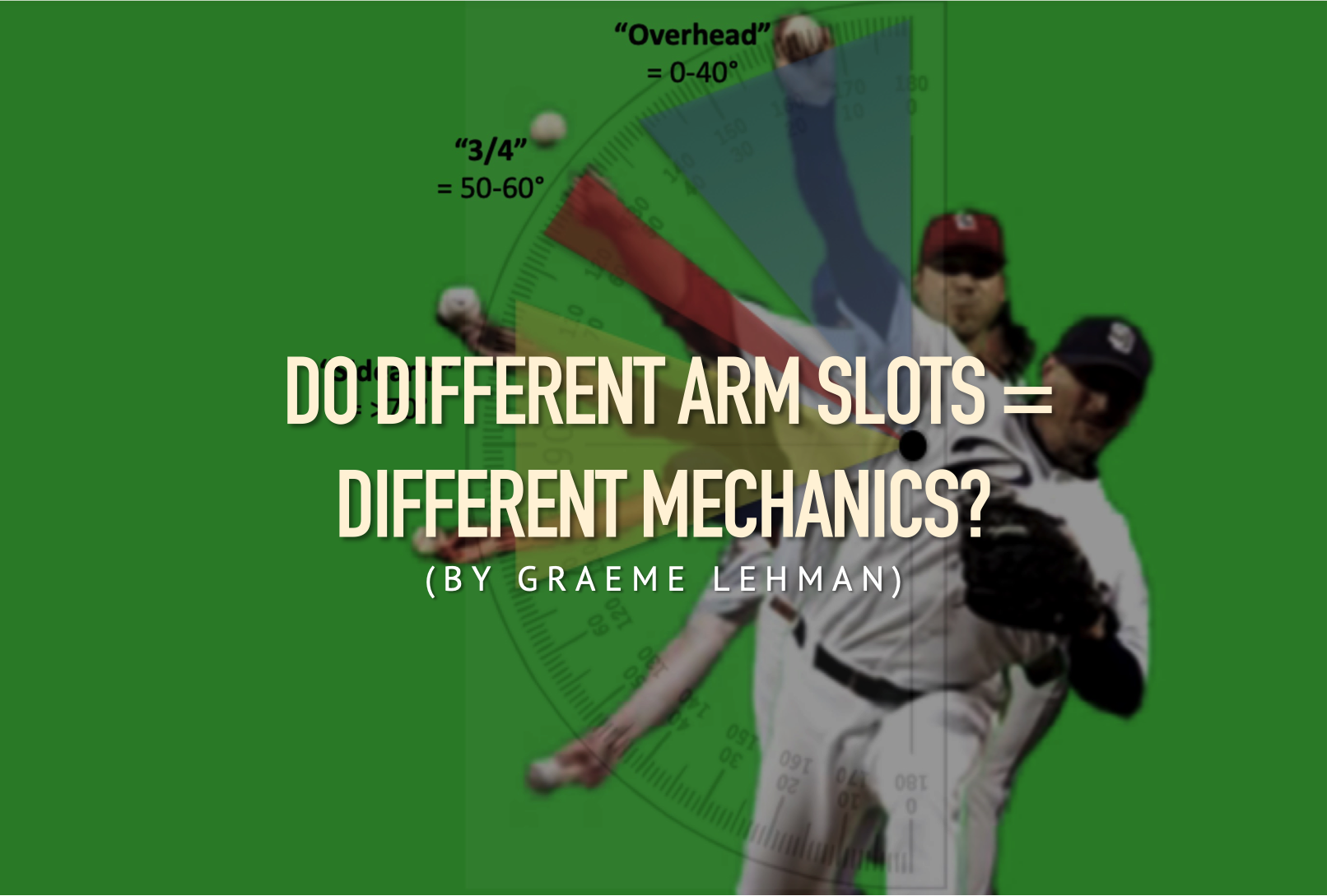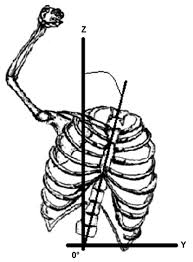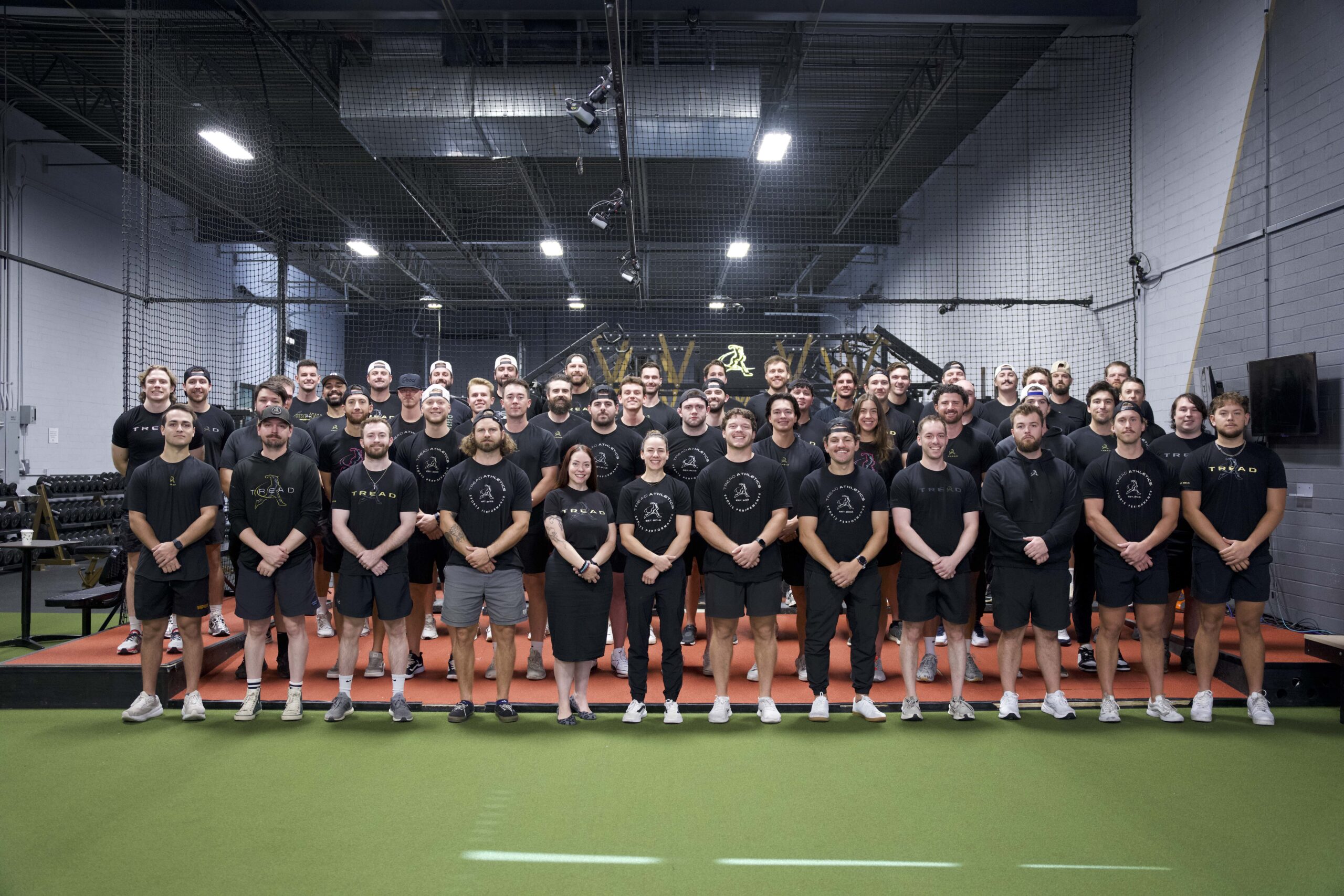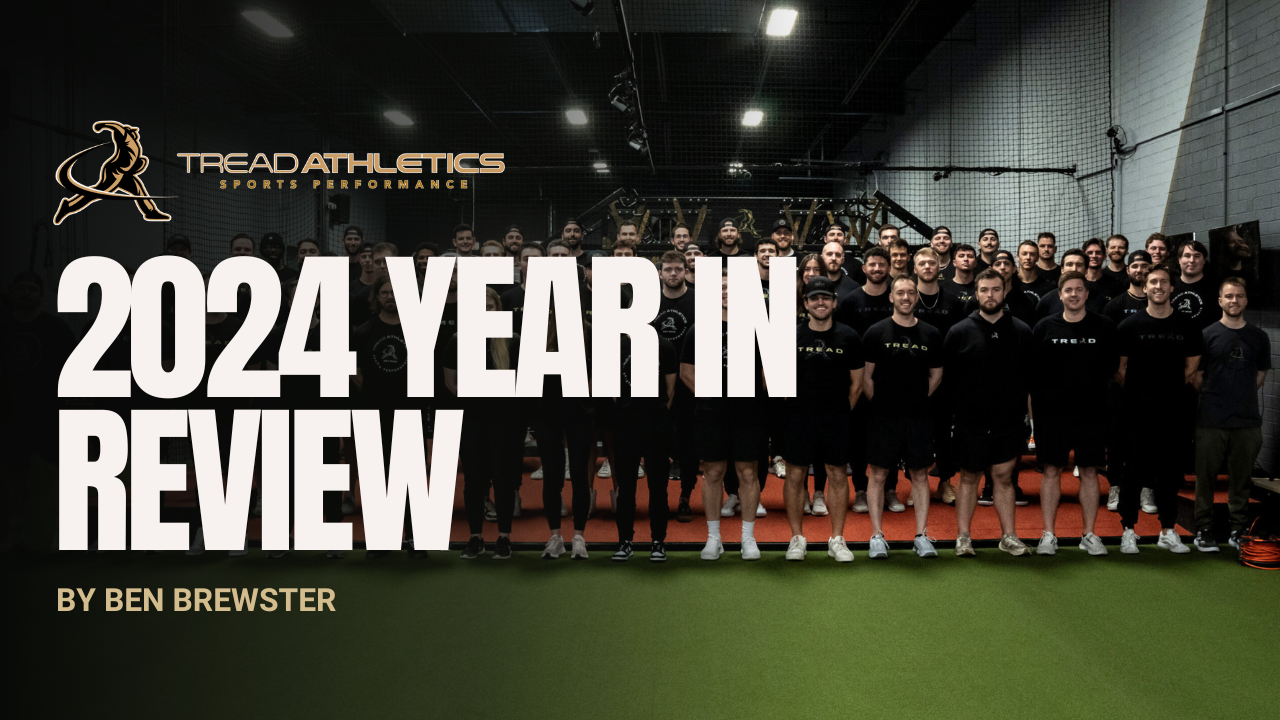by Graeme Lehman, MSc, CSCS
Today’s article comes to you from Graeme Lehman (MSc, CSCS). Graeme has extensive practical and academic experience in the field of baseball strength and conditioning. You may remember him from his guest post on grunting and velocity, or from his Master’s Thesis on how various lower-body field tests correlate with throwing velocity. He can be reached by email or through his website. This article was originally published on his blog and can be viewed there as well.
Categorizing pitchers based on their arm slot is easy. You can see it with your naked eye and the language within baseball already exists.
But is arm slot the only mechanical difference between these types of deliveries? And if they are different doesn’t this mean that we as coaches should have some cues and training methods that vary across the arm slot spectrum?
These are the questions that I am interested in and I am going to do my best to answer the first question of mechanical differences with some information from some recent research. This type of knowledge is useful because when we do go and categorize pitchers based off of their arm slot it will provide a deeper base of knowledge.
“Categorization is the process in which ideas and objects are recognized, differentiated, and understood. [The primary task of categorization is] to provide maximum information with the least cognitive effort.”-Rosch, 1978. Principles of Categorization
I am all about this quote, especially that last part about the most information with the least effort. This might be the new motto that I use when trying to write an article.
Here’s the research paper that I am using for this article:
I highly suggest you take a look at it because their main findings of which arm slot is at a higher risk for sustaining either a UCL or SLAP tear is interesting and very important.
What I am going to do is look at differences between these arm slots:
- Overhand – Less than 40 degrees
- Three-quarters – Between 50 & 60 degrees
- Side Arm – More than 70 degrees


When it comes to vital aspects of pitching mechanics that relate to producing velocity like:
- Amount of External Rotation (layback)
- Hip and Shoulder Separation
- Front Leg Action
- Back Leg Action
- Forward Trunk Tilt at Ball Release
**They didn’t include any pitchers that threw with arm angles that were in the 40-50 & 60-70 degree range in order to make the distinctions more clear cut**
***Editor’s side note: the velocity across all groups was ~38 m/s or ~85 mph, which is reasonably advanced as far as studies go for pitchers, but especially advanced for sidearm pitchers. It’s possible we’re looking at very elite sidearmers, and relatively average 3/4 or overhead pitchers. This doesn’t discredit the study, but it’s an observation that may impact how we interpret the following results.***
Before we get into the small variations between the mechanics of pitchers with different arm slots at these critical points let’s look at the obvious differences. Shoulder abduction and contralateral tilt are two factors that play the biggest role in determining where that arm is in relation to the body.

Shoulder Abduction
One trait that separated all three groups from each other is the amount of shoulder abduction at ball release. All three groups had fairly similar angles of abduction when the front foot first hit the ground (89-OH, 89-3/4, 84-SA) but by the time the ball was being released the difference were significant. The OH group ended up with the most at 94 degrees while the ¾ group stayed nearly the same while the Sidearm group dropped their elbow slightly down to 81 degrees.
This is in-line with other research that states that in order to produce the most power the shoulder needs to be in and around the 90-degree mark of shoulder abduction since this is the strongest angle.
Contralateral Tilt
The biggest contributing factor to arm slot is the amount of contralateral tilt. In the past, I’ve written about contralateral tilt here and here. Its basically describes how far your upper body is tilting to the side in order to allow your arm to be in its desired arm slot while staying near that magic 90-degree mark. The contralateral tilt for this skinny guy below is the difference between his sternum (aka breast bone) and the vertical line labeled “Z”
The numbers for this group were as follows
These are significantly different from one another but again was obvious. Although it is nice to put some hard numbers to these traits in order to add some depth to our categorization system.
Now that we got that out of the way with let’s dig into the smaller differences so that we can add more intel into our already existing categorization scheme.
The Study Details
I picked these parameters based on other research like this which I wrote about here.
Hip and Shoulder Separation
This study did not tell us how much hip an shoulder separation occurred but one thing that I found to be interesting was the timing between peak pelvic and shoulder rotations. Each group displayed a delay and separation between the hip’s and shoulder’s each reaching top rotational speeds towards home plate but the timing was different for each arm slot.
The really cool and high tech graphic below is a visual representation of the timing between the hips (triangles) and the shoulders (lightning bolts) and when they reached their peak velocity in the delivery. The timing values that we see are in the form of a percentage between 0%, the point when your front foot hits the ground, and 100%, when the ball is released.
One might think that the group who reached peak rotation of the hips the soonest would also be the first group to have their shoulders reach top speed. That is not the case.
The sidearm group in yellow rotated their hips later but their shoulders sooner while the Overhead group had the biggest amount of time between these two events. When we look at exactly how fast the hips are rotating in degrees per second the sidearm group was significantly faster than either of the other two arm slot groups. Maybe this groups uses the added time to build up more hip rotation velocity? Maybe they rely more on a “rotational” type of delivery versus a linear?? These are just some of the many follow up questions that happen every time I learn something new.
It should be noted that the Sidearm group also landed with their foot in a closed position which means that their hips didn’t have to rotate as much. We don’t know exactly how much rotation is occurring since it isn’t reported but we can make this assumption.
Another interesting point is that the Overhead group reached their peak hip rotation the earliest while their shoulders reached their peaked the latest. This, in essence, would provide more time to create hip and shoulder separation. More time can lead to the POTENTIAL of creating more force but not always.
Max External Rotation
Another key piece of information is that the Sidearm group has significantly more external rotation at the shoulder joint than either of the other two arm slots. The Sidearm throwers average 169 degrees of external rotation whereas the Overhead and 3/4’s displayed 162 & 163 degrees respectively.
More ER allows for added time to have force applied to the baseball which is good but some pitchers may be able to reach elite levels by internally rotating faster with less ER. This is tough to coach but its still good info.
“More ER allows for added time to have force applied to the baseball…but some pitchers may be able to reach elite levels by internally rotating faster with less ER.”
It should be noted that upper back mobility (t-spine) as well as scapular posterior tilt can add to that overall “lay back” position of the forearm – it’s not all external rotation at the glenohumeral joint. Maybe the other two arm slots allow for more T-spine extension and rotation which make up for the lack ER at the shoulder.
Front Leg Action
The action of the front leg is vital. Harder throwers extend their front leg between the time that the front foot hits the ground to the time when the ball is released. Or at least stays the same angle.
All three groups displayed this critical mechanical principal in varying degrees. The Sidearm pitchers landed at front foot contact (FFC) taller with the leg being the straightest at 39 degrees but only extended a little bit to 37 degrees at ball release (BR). This isn’t a lot of movement and would look more like landing on a stiff leg. The ¾’s group had the greatest amount of extension with 8 degrees going from 43 at FFC to 35 at BR. The overhead group displays the most amount of knee bend at FFC (44) upon landing and extends to 39 degrees. Keep in mind that the front leg will keep extending after the ball is release which gives these kinds of images of pitchers really getting aggressive with that front leg so that they can catapult baseballs out of their hands at incredible speeds. Like we see here with Otani.
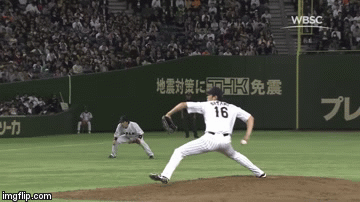
Back Leg Action
The information that we get about the back leg is minimal. No force plates were used to see how much energy is being produced and when it’s being applied and in which direction.
We do get the max height of their front knee when they pick that leg up during the windup which can tell us a bit about how they are using their bag leg. We also get to see how much “pelvic drift” occurs when they are at max knee height. This term “pelvic drift” in this case is how much the front hip is leading towards home plate.
What we see is that the Sidearm group is significantly different than the 3/4 and Overhead groups who were almost identical to one another.
The sidearm group of pitchers didn’t lift their knee as high but lead with their hips more than the other groups.
“The sidearm group of pitchers didn’t lift their knee as high but lead with their hips more than the other groups.”
Here’s a famous sidearmer displaying some “pelvic hip drift”. His knee lift looks high but when you look at it relative to his standing height, like they did in this study, its pretty low.

It’s a far stretch but you could try to build an idea in your head about how a pitcher uses their back leg with these pieces of information. Lifting your front knee higher does give you more opportunity to apply force into the ground since the left leg (for righties) has more time and distance to build up speed as it comes back down towards the ground helping to add to the overall amount of force going into the ground. The more you put in the more you can get out – in theory. But it works for jumping with aggressive arm actions downwards prior to take-off. Just watch the NFL combine this year and you will see crazy arms actions prior to take-off in both the vertical and broad jumps.
I remember hearing a story that Nolan Ryan simply told Tom House to “put that into your computer” when described how he felt about the relationship of lifting his leg higher and throwing harder.

The info about the amount of hip drift can be massaged into getting an idea about the direction that they are applying force into the ground.
We know that we need to get force back from the earth going in the direction of where you want to throw the ball. But if our lead hip has been pushed out front we’ve created the opportunity push into the ground with your back leg in a bit more of a horizontal angle rather than pushing straight down into the ground like you would when testing your vertical jump.
Teaching someone about to maximize the exchange of energy between how much we put into the ground and how we get back is vital. Its easier to explain with something simple like the vertical jump since the energy is being exchanged in opposite directions. One of the many, many reasons that pitching is complicated is that you have to master exchanging this energy going in different directions. We have to go from applying force into the ground vertically and getting it back horizontally towards home plate. The degree of just how vertically we are applying force into the ground can vary from pitchers to pitcher. If we look at the guys in the previous two pictures, who happen to be number 1 and 2 in all-time strikeout in the MLB, we can see that Mr. Johnson is must be applying force into the ground more horizontally than Mr. Ryan. Here’s another high tech graph to show you what I mean.
Here we see how they have both altered the shin angle of the back leg during this exchange of putting energy into the ground and then getting as much of it as we can, in a controlled yet powerful manner, back towards our target.
Just to clarify, I am stretching this information that I’m getting from a real study into these ideas. But I think that they make a little bit of sense otherwise I wouldn’t have spent so much time writing about them. Sounds like something that I need to explore and elaborate on more in a future article.
Forward Trunk Tilt
The amount of forward trunk tilt at ball release is another biomechanical point that has been shown to correlate with velocity. This study had the “fast throwers” with trunk tilt of 36 degrees while the “slow thrower” was more upright at 28 degrees. All three of the various arm slot group were within this range.
This piece of information is interesting as well. Not only does forward trunk tilt provide an advantage from an effective velocity point of view since the release point is closer to home plate. We can also think of forward trunk tilt as providing more time to create more power as well.
Wrap Up
There will obviously be variations within each arm slot itself and some of this information might not apply to every pitcher. The aim here was to at the very least add this information into an already existing categorization scheme of pitchers based on their arm slot. The goal would then be to take this information and formulate ideas of how we should adjust our training and coaching to these athletes with different approaches to a common goal of throwing hard, safe and accurate.
That’s the tough part but I hope this is a step in the right direction.
Graeme Lehman, MSc, CSCS
Athletes or coaches interested in remote one-on-one or team programming? Reach out via this application form.

